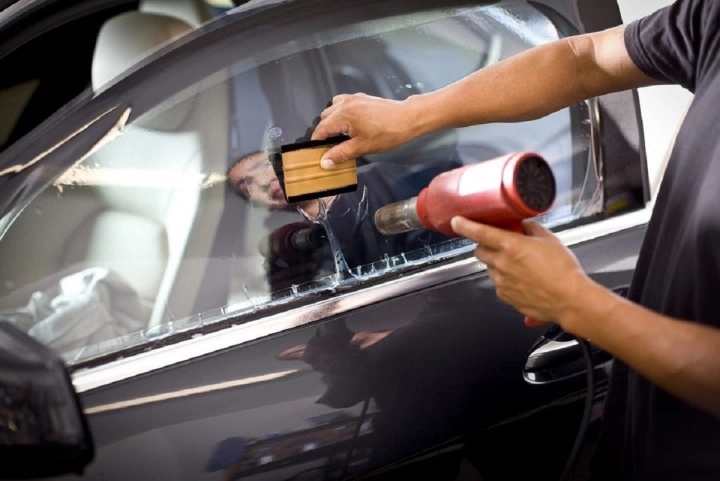What colors are available for window tinting film?
There are currently two types of window tinting film: single-color film and dual-color film with different colors on each side, with white and black being the most popular. Additionally, there are other colors available such as moss green, sea blue, silver gray, blue, red, and silver.
Depending on personal preferences and styles, there are various options to choose from that match the shape and color of the car. White is considered the most suitable color.

Choosing the color of window tinting film depends on each individual’s preference, but many drivers believe that dark colors should not be chosen. (Illustrative image).
However, if you want to choose a color that creates a “cool” and fresh style, you can choose black window tinting film. If you want a more unique color, you can use silver gray.
Why should you avoid using dark window tinting film?
According to experts, using excessively dark window tinting film can provide heat insulation but will reduce the driver’s visibility, especially at night.
Mr. Doan Van Trinh (Long Bien, Hanoi) shared that he tinted his windows with dark film right after purchasing his car a year ago. Now, he has to go to a store to remove the film because it makes it difficult for him to observe the road while driving at night.
“I used good quality dark film to reduce the heat. It’s no problem when driving during the day, but in the evening and later, it’s very difficult to see outside the car, making it hard to observe the surroundings and almost hitting motorcycles closely passing by,” he said.
Window tinting film is a popular accessory for car users in Vietnam due to the hot and sunny climate. Some manufacturers even apply window tinting film before delivering cars to customers. Tinted windows have advantages such as providing cooler temperatures, more privacy, and some can even reduce glare from other headlights.
In Vietnam, there are currently no regulations regarding window tinting film for cars, and there are no laws regarding the handling and punishment of car owners who use excessively dark window tinting film. Therefore, users can choose window tinting film with various degrees of translucency as they wish.
Visible Light Transmittance (VLT) represents the amount of visible light that can pass through the window tinting film and into the car cabin. VLT is measured by percentage, where a lower VLT means less light can pass through. In countries where window tinting film is allowed on the windshield, the minimum VLT is usually 70%, which is the smallest value to ensure visibility.
To achieve cooler temperatures, many car owners in Vietnam tend to use window tinting film with a VLT lower than 70%, meaning less light can pass through. With this type of film, the driver will feel cooler when driving in intense sunlight, and the interior space of the car will also be more private. However, due to the reduced light transmission, the driver’s visibility and ability to perceive differences in actual lighting conditions on the road may be affected, which can cause accidents for themselves and others. Window tinting film in this case becomes a “double-edged sword”.
The risks do not end with applying the window tinting film, as removing the film also has its impact. After many near accidents, Mr. Trinh decided to choose window tinting film with a higher VLT. However, when removing the previous film, the small copper wires on the rear windshield that were used for defrosting also peeled off. The technicians had previously advised him, and Mr. Trinh accepted it because he rarely used this feature.
Answering VTC News, Mr. Tran Van Chung, Director of Tran Chung Car Garage (Dinh Nup, Cau Giay, Hanoi), suggests that car owners should try out different types of window tinting film on their own car models at window tinting centers.
“Car owners should try it in the morning, when there is intense sunlight, to see the effectiveness of heat insulation, and try it at night to check the darkness of the film and its effectiveness in reducing glare. In addition, they should try the film on all parts of the windows, including the side and rear windows,” Mr. Chung said.
Currently, window tinting centers often recommend window films with a VLT of 55-80% for the front windshield, 20-60% for the driver’s and passenger’s side windows, and the other windows depend on the customer’s usage needs. In addition to the windshield, the front side windows are also places where window films with low VLT should not be used, as the driver will frequently need to observe the rear-view mirrors through these windows.
Source: vtc.vn





































